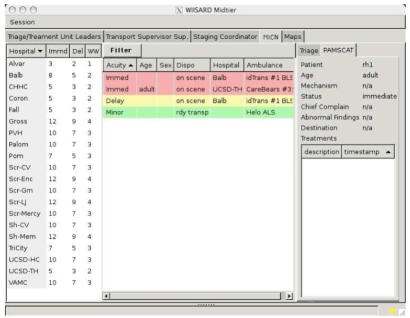Abstract
The WIISARD disaster response patient tracking program that allows for improved process flow, communication, and patient care using sophisticated wireless technology to coordinate and enhance the care of mass casualties in terrorist attacks or natural disasters. The MICN device has been developed as the link between the Base Station Mobile Intensive Care Nurse and Incident Command in the field. This tool allows the MICN coordinating the incident from the hospital side to more effectively and efficiently communicate with the Incident Command for the accurate and rapid distribution of patients from the scene to the hospitals.
Mass Casualty Incidents (MCIs) are typically coordinated from a single regional hospital Base Station in which the Mobile Intensive Care Nurse (MICN) acts as the liaison between the incident command (IC) in the field and the receiving hospitals. The MICNs are mid-tier first responders who collect and maintain bed availability and treatment capabilities of hospitals via radio with each hospital. The MICN converts resource data to estimates of ability to receive START triage rated casualties from the scene.
The objective of the software system described herein is to simplify the collection and transfer between the MICN and its on-field counterpart the Transport Supervisor using wireless technology. The MICN and the Transport Supervisor are responsible for obtaining hospital availability and capability information, coordinating the transfer of patients from the field to the scene, then summarizing all of these events into a final report. The challenge has been to keep track of the receiving capabilities of each hospital, where the patients are going, and which units will be transporting these patients while maintaining paper records of the incident.
To support real-time collaboration between the MICN and the Transport Officer we have developed a software system implemented on a laptop computer with wireless connectivity to a main database.
The capabilities available to the MICNs include a modifiable list of hospitals, beds available, hospital capabilities; patient list and acuity, disposition, destination, and transporting unit; a summary of each patient’s information; access to general scene information; message posting capability for hospitals and for the field; and final report creation.
The MICN obtains the bed availability and capabilities from each of the hospitals. He or she can also view specific details of patients injuries to help the field disposition all of the patients needing transport. The MICN uses this interface to instantly communicate bed availability changes to the IC and the Transport officer, pertinent patient information to the receiving hospitals, and to act as liaison between the hospitals and the field IC as the need arises.
The left hand side of this three part interface is a list of active hospitals responding to the incident. The name and capacity for patients in each START category are shown in the window. Selecting a hospital results in a list of victims dispatched to that hospital in the middle window. The right most window is used to update available capacity to receive casualties and to view clinical details on a single patient selected in the middle window.
The amount of information being recorded and transferred from a disaster scene to the receiving hospitals can be overwhelming and accurate record keeping is difficult. It is imperative to have immediate access to this information for the coordinated transport of these patients to appropriate health care facilities. The WIISARD MICN device is designed to facilitate this. Tests of the interface will be conducted in an exercise in August 2006.
Reference
- 1.Buono C, et al. Role-Tailored Software Systems for Coordinating Care at Disaster Sites: Enhancing the Capabilities of “Mid-Tier” Responders. Proceedings 2005 AMIA Fall Symposium. :908. [PMC free article] [PubMed] [Google Scholar]



